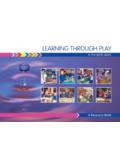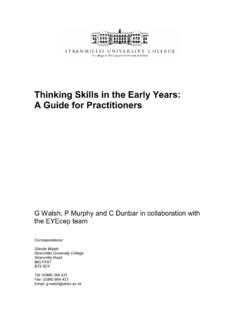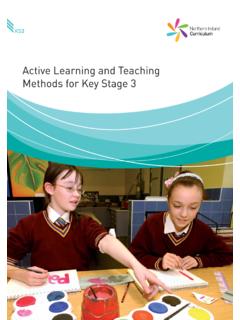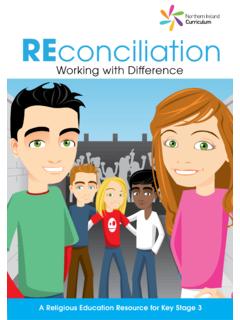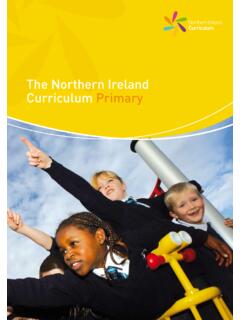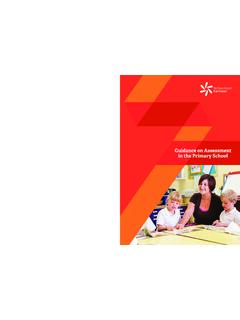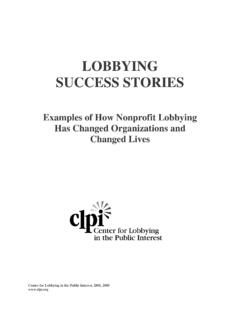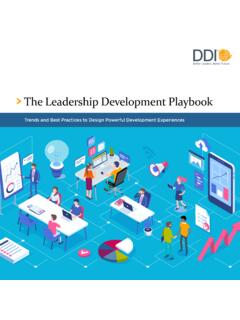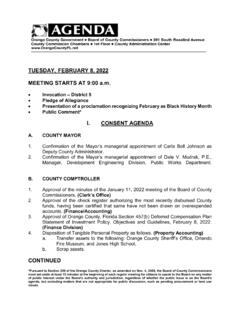Transcription of Gifted and Talented Pupils - Curriculum | CCEA
1 Gifted andTalented PupilsGuidelines for Teachers CCEA 2007 Gifted and Talented Pupils Guidelines for TeachersCCEA Gifted andTalented PupilsGuidelines for Teachers1. IntroductionDefinition 7 Using these Guidelines 92. IdentificationObservation 15 Parent/Carer Nomination 15 Peer Nomination 18 Self Nomination 18 Nomination by Others 18 Identification by Psychologists 19 Teacher Nomination 19 General Checklist for Identifying Giftedand Talented Students 22 Subject-Specific Checklists 25 School-Wide Identification Processes 423. Whole-School StrategiesSchool leadership Responsibilities 45 Auditing Current Practice 45 Policies 47 The School Register 47 School Organisational Strategies 484. Classroom StrategiesDifferentiation 52 Higher Order Learning Skills:Bloom s Taxonomy 56 Multiple Intelligences ( gardner 1999) 645.
2 Gender and GiftednessEarly Developmental Differencesbetween Gifted and TalentedGirls and Boys 69 Specific Challenges Facing Young Children 70 Specific Challenges Facing Older Students 76 Beyond School 796. Profiles of the Gifted and Talented The Successfuls 82 The Challengings 84 The Undergrounds 86 The Dropouts 88 The Double-Labelled 90 The Autonomous Learners 927. Conclusion 958. AppendicesAppendix ICase Studies from Northern Ireland 96 Appendix II Voices from the Republic of Ireland 122 Appendix IIIE xemplar Policy: Gifted and Talented Education 140 Appendix IVUseful Forms 146 References 156 Acknowledgements 157 ContentsGifted and Talented Pupilspage 3 Myths & TruthsTruthGifted and Talented students have problems like any other student.
3 They may have learning disabilities which they can hide while the work is easier. It becomes harder and harder for them to excel, which can lead to behavioural problems and and Talented students will always do well whatever the circu msta and Talented Pupilspage 4 TruthGifted and Talented students can feel isolated and misunderstood. They may have more adult tastes in music, clothing, reading material and food. These differences can cause them to be shunned and even abused verbally or physically by other may appear to do well on their own but without focused challenge they can become bored and disruptive. As time passes they may find it harder and harder as the work becomes more difficult, since they have never faced challenge a nd Talented stu dents a re so clever they do well with or without special edu it s true that children need to play and interact socially with other children their age, they do not need to learn with them.
4 For example the case of a Gifted and Talented learner who has a chronological age of six and a mental age of 11 and has been reading since two. To put that child in a reading class with other six year olds who are just learning to read can be demotivating for that need to go throu gh school lea rning with their own age a bility is something of which to be and Talented Pupilspage 5 Status of this DocumentThese guidelines are non-statutory. They aim to support the teaching and learning of Gifted and Talented students. They reflect good practice which is already taking place in schools throughout Northern Ireland. This may be seen in the case studies in Appendix I. They are consistent with the aims and objectives of the Revised Northern Ireland Curriculum .
5 These guidelines are a product of a collaborative approach between Northern Ireland s Council for Curriculum , Examinations and Assessment (CCEA) and the National Council for Curriculum and Assessment (NCCA) in the Republic of Ireland. Due to differences in the educational systems and legislation, the documents produced will have some order to draw upon the most recent research and good practice in this area, a comprehensive literature review was compiled. The review, titled Gifted and Talented Children in (and out of) the Classroom (CCEA, 2006), is available on should be noted that some of the language in this document is that of the researchers quoted and not that of CCEA or NCCA. These sections are included to give as wide a range of opinionas and Talented Pupilspage 6 There is no universally agreed definition of students who would be assessed as Gifted and Talented .
6 Some accepted terms are genius, more able, exceptionally able, very able, Gifted and Talented , bright, virtuoso and high the purpose of this document, CCEA has used the term Gifted and Talented to describe those students who are achieving or who have the potential to achieve a level substantially beyond the rest of their peer group inside their particular school, be that school a nursery, primary, selective and non-selective post-primary school or other educational students who demonstrate or have the potential to demonstrate extremely high levels of ability, compared to their peers across the entire population, will be referred to by the term Exceptionally Able. The terms Gifted and Talented or Exceptionally Able encompass students who are able across the Curriculum as well as those who show talent in one or more specific areas.
7 All talents and gifts are equally valued and should be allocated equal time and resources across the educational the absence of an agreed definition of the terms Gifted and Talented and Exceptionally Able , we have assumed that the student s abilities will be in one or more of the following areas:- general intellectual ability or talent;- specific academic aptitude or talent;- visual and performing arts and sports;- leadership ability;- creative and productive thinking;- mechanical ingenuity; and- special abilities in empathy, understanding and Caution should be exercised with regard to relying solely on IQ measures, as exceptional abilities in aspects such as creativity, leadership , art, social and physical skills may not be identified.
8 Also, Gifted and Talented students who may present with a learning difficulty or a secondary exceptionality may have depressed scores which may not be indicative of their true potential in other guidelines can be used by:- schools to raise awareness among staff, students and parents;- school management to audit and review school policy and practice for Gifted and Talented students and to further develop an inclusive school ethos;- schools to introduce identification strategies;- school management to create a school development plan and/or departmental action plans;- universities and further education colleges to inform initial teacher training;- schools management to target CPD;- whole-school implementation (including strategies for emotional well-being of students, including contacts with parents);- individual teachers and classroom assistants to identify the strengths and areas for development in their practice with Gifted and Talented students and, therefore, develop classroom implementation;- others for evaluation for future policies (including classroom, school, CCEA, ELBs, ESA from 2009, Department for Education, initial teacher training);- parents and carers to support their son/daughter.
9 And/or- Gifted and Talented students for these Guidelines Gifted and Talented Pupilspage 9 IdentificationMa ry Lea key, e minent a nthropologist, was repeatedly expelled from her Catholic Convent mple Gra ndin, PhD, was diagnosed with brain da mage at age two a nd is now a n associate professor at Colorado State University a nd a rgu a bly the most a ccomplished adult with high fu nctioning a utism in the world. She is also a world renowned professional designer of hu ma ne livestock fa cilities. F. W. Woolworth got a job in a dry goods store when he was 21. He would not serve customers as he la cked the confidence. Ability is not always easy to spot! Gifted and Talented Pupilspage 10Ca ruso s music tea cher told hi m Y ou ca n t sing, you have no voice at all.
10 Joh n Len non s school report read: Hopeless. Certainly on the road to failu re .Abra ha m Lincoln entered The Bla ck Hawk Wa r as a captain a nd ca me out a was fou r yea rs old before he could spea k a nd seven before he could read. Napoleon finished nea r the bottom of his class at milita ry school, yet beca me one of the leading milita ry men of all ti m Butler Y eats ea rly school report described his performa nce as Only fair. Perhaps better in Latin tha n a ny other su bject. Very poor in spelling . The K a nsas City Sta r editor fired Walt Disney beca use of la ck of creativity. Ma ria Callas was rejected by the prestigious Athens Conservatoire. At the a u dition her voice failed to i mpress.
